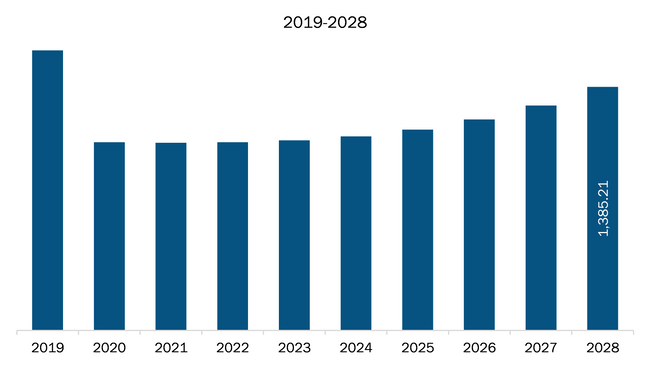The LATAM fixed-base operator market was valued at US$ 1,067.72 million in 2021 and is projected to reach US$ 1,385.21 million by 2028; it is estimated to register a CAGR of 3.8% from 2021 to 2028.
The overall LATAM fixed-base operator market is witnessing slow growth compared to other regions such as North America and Europe, majorly due to few countries still trying to catch up with the service levels that are far from standardized. The general aviation sector in LATAM is expected to rise during the forecast period, demanding the FBO service providers to offer enhanced services to travelers. Moreover, the operational cost of FBOs is high in the developing countries in the current scenario. This is because the number of FBOs is comparatively less in the developing countries of LATAM. The operational cost involves maintenance of proper service infrastructure, rents of premises, and staffing.
Further, many initiatives are taken in the region, propelling the demand for FBOs across Latin America. For instance, the LATIN America FBO forum was held from December 7 to December 9, 2021. Such initiatives are anticipated to propel the demand for FBOs. Thus, a slow but promising increase in the number of FBOs in LATAM is emerging as one of the significant opportunities for fixed-base operator market growth.
Owing to the COVID-19 outbreak, LATAM experienced a significant decline in production volumes from the aviation industry. There is a lack of aircraft parking and general aviation (GA) infrastructure throughout the LATAM region. However, with the formation of local flight departments in the region, the fixed-base operator market will strengthen and encourage improvement in infrastructure and general aviation services. Further, the region is experiencing a decline in travel and tourism-related activities, owing to the containment measures imposed by governments, ultimately hindering the adoption of fixed-base operators services. Also, the discontinuation of fixed-base operator projects in Argentina, Colombia, Peru, and Chile, among other Latin American countries, and disruption in the supply chain of the aviation industry in the region are affecting the market growth. For instance, the manufacturing sector in countries such as Brazil and Argentina is experiencing low production, thereby indirectly impacting the business aviation sector of the market. All such factors impacted the fixed-base operator market growth in the LATAM region. However, countries in the region are likely to overcome the COVID situation once the economic activities are back on track, especially between 2021 and 2022.
The LATAM fixed-base operator market size is divided into services offered, application, and geography. Based on services offered, the LATAM fixed-base operator market is segmented into hangaring, fueling, flight instruction, aircraft maintenance, and aircraft rental. In terms of application, the LATAM fixed-base operator market is segmented into business aviation and leisure aviation. Geographically, the LATAM fixed-base operator market is segmented into Brazil, Argentina, Mexico, and the Rest of LATAM.
ICCS; World-Way Aviation; Signature Flight Support; Líder Aviação; South American Jets, LLC; Universal Weather and Aviation, Inc.; Loreto Aviation Services; Jetex; LOBOS HANDLING; and TALMA are among the key players that are profiled during the study of LATAM fixed-base operator market.
LATAM Fixed-Base Operator Market Revenue and Forecast to 2028 (US$ million)

- Sample PDF showcases the content structure and the nature of the information with qualitative and quantitative analysis.
- Request discounts available for Start-Ups & Universities

Report Coverage
Revenue forecast, Company Analysis, Industry landscape, Growth factors, and Trends

Segment Covered
This text is related
to segments covered.

Regional Scope
North America, Europe, Asia Pacific, Middle East & Africa, South & Central America

Country Scope
This text is related
to country scope.
1. Introduction
1.1 Study Scope
1.2 The Insight Partners Research Report Guidance
1.3 Market Segmentation
2. Key Takeaways
3. Research Methodology
3.1 Coverage
3.2 Secondary Research
3.3 Primary Research
4. LATAM Fixed-Based Operator Market Landscape
4.1 Market Overview
4.2 Porter’s Five Forces Analysis
4.3 Ecosystem Analysis
4.4 Expert Opinions
5. LATAM Fixed-Base Operator Market –Market Dynamics
5.1 Market Driver
5.1.1 Growth of Business Aviation Sector
5.1.2 Fuelling Services Contribute Significantly to FBO Service Business
5.2 Market Restraint
5.2.1 Staffing Shortages and High Operational Costs
5.3 Market Opportunity
5.3.1 High Potential for FBOs in LATAM Region
5.4 Trends:
5.4.1 Escalating Demand for Hangaring Services for Varied Sized-Aircraft
5.5 Impact Analysis of Drivers and Restraints
6. Fixed-Base Operator Market – LATAM Analysis
6.1 LATAM Fixed-Based Operator Market Overview
6.2 LATAM Fixed-Based Operator Market – Revenue and Forecast to 2028 (US$ Million)
6.3 Market Positioning – Five Key Players
7. LATAM Fixed-Based Operator Market Analysis– By Services Offered
7.1 Overview
7.2 Fixed-Base Operator Market, by Services Offered (2020 and 2028)
7.3 Hangaring
7.3.1 Overview
7.3.2 Hangaring: Fixed-Base Operator Market – Revenue and Forecast to 2028 (US$ Million)
7.4 Fuelling
7.4.1 Overview
7.4.2 Fuelling: Fixed-Base Operator Market – Revenue and Forecast to 2028 (US$ Million)
7.5 Flight Instructions
7.5.1 Overview
7.5.2 Flight Instructions: Fixed-Base Operator Market – Revenue and Forecast to 2028 (US$ Million)
7.6 Aircraft Maintenance
7.6.1 Overview
7.6.2 Aircraft Maintenance: Fixed-Base Operator Market – Revenue and Forecast to 2028 (US$ Million)
7.7 Aircraft Rental
7.7.1 Overview
7.7.2 Aircraft Rental: Fixed-Base Operator Market – Revenue and Forecast to 2028 (US$ Million)
8. LATAM Fixed-Base Operator Market Analysis – By Application
8.1 Overview
8.2 Fixed-Base Operator Market, by Application (2020 and 2028)
8.3 Business Aviation
8.3.1 Overview
8.3.2 Business Aviation: Fixed-Base Operator Market – Revenue and Forecast to 2028 (US$ Million)
8.4 Leisure Aviation
8.4.1 Overview
8.4.2 Leisure Aviation: Fixed-Base Operator Market – Revenue and Forecast to 2028 (US$ Million)
9. LATAM Fixed-Based Operator Market – Country Analysis
9.1 LATAM: Fixed-Base Operator Market, By Country
9.1.1 Brazil: Fixed-Base Operator Market – Revenue and Forecast to 2028 (US$ Million)
9.1.1.1 Brazil: Fixed-Base Operator Market- by Services Offered
9.1.1.2 Brazil: Fixed-Base Operator Market- By Application
9.1.2 Argentina: Fixed-Base Operator Market – Revenue and Forecast to 2028 (US$ Million)
9.1.2.1 Argentina: Fixed-Base Operator Market- by Services Offered
9.1.2.2 Argentina: Fixed-Base Operator Market- By Application
9.1.3 Mexico: Fixed-Base Operator Market – Revenue and Forecast to 2028 (US$ Million)
9.1.3.1 Mexico: Fixed-Base Operator Market- by Services Offered
9.1.3.2 Mexico: Fixed-Base Operator Market- By Application
9.1.4 Rest of LATAM: Fixed-Base Operator Market – Revenue and Forecast to 2028 (US$ Million)
9.1.4.1 Rest of LATAM: Fixed-Base Operator Market- by Services Offered
9.1.4.2 Rest of LATAM: Fixed-Base Operator Market- By Application
10. LATAM Fixed-Base Operator Market- COVID-19 Impact Analysis
10.1 Overview
10.2 LATAM
11. Industry Landscape
11.1 Market Initiatives
12. Company Profiles
12.1 ICCS
12.1.1 Key Facts
12.1.2 Business Description
12.1.3 Products and Services
12.1.4 Financial Overview
12.1.5 SWOT Analysis
12.1.6 Key Developments
12.2 World-Way Aviation
12.2.1 Key Facts
12.2.2 Business Description
12.2.3 Products and Services
12.2.4 Financial Overview
12.2.5 SWOT Analysis
12.2.6 Key Developments
12.3 Signature Aviation Limited
12.3.1 Key Facts
12.3.2 Business Description
12.3.3 Products and Services
12.3.4 Financial Overview
12.3.5 SWOT Analysis
12.3.6 Key Developments
12.4 Líder Aviação
12.4.1 Key Facts
12.4.2 Business Description
12.4.3 Products and Services
12.4.4 Financial Overview
12.4.5 SWOT Analysis
12.4.6 Key Developments
12.5 South American Jets, LLC.
12.5.1 Key Facts
12.5.2 Business Description
12.5.3 Products and Services
12.5.4 Financial Overview
12.5.5 SWOT Analysis
12.5.6 Key Developments
12.6 Universal Weather and Aviation, Inc.
12.6.1 Key Facts
12.6.2 Business Description
12.6.3 Products and Services
12.6.4 Financial Overview
12.6.5 SWOT Analysis
12.6.6 Key Developments
12.7 Loreto Aviation Services
12.7.1 Key Facts
12.7.2 Business Description
12.7.3 Products and Services
12.7.4 Financial Overview
12.7.5 SWOT Analysis
12.7.6 Key Developments
12.8 Jetex
12.8.1 Key Facts
12.8.2 Business Description
12.8.3 Products and Services
12.8.4 Financial Overview
12.8.5 SWOT Analysis
12.8.6 Key Developments
12.9 LOBOS HANDLING
12.9.1 Key Facts
12.9.2 Business Description
12.9.3 Products and Services
12.9.4 Financial Overview
12.9.5 SWOT Analysis
12.9.6 Key Developments
12.10 TALMA
12.10.1 Key Facts
12.10.2 Business Description
12.10.3 Products and Services
12.10.4 Financial Overview
12.10.5 SWOT Analysis
12.10.6 Key Developments
13. Appendix
13.1 About The Insight Partners
13.2 Word Index
LIST OF TABLES
Table 1. LATAM Fixed-Based Operator Market – Revenue and Forecast to 2028 (US$ Million)
Table 2. Brazil: Fixed-Base Operator Market- by Services Offered –Revenue and Forecast to 2028 (US$ Million)
Table 3. Brazil: Fixed-Base Operator Market- By Application –Revenue and Forecast to 2028 (US$ Million)
Table 4. Argentina: Fixed-Base Operator Market- by Services Offered –Revenue and Forecast to 2028 (US$ Million)
Table 5. Argentina: Fixed-Base Operator Market- By Application –Revenue and Forecast to 2028 (US$ Million)
Table 6. Mexico: Fixed-Base Operator Market- by Services Offered –Revenue and Forecast to 2028 (US$ Million)
Table 7. Mexico: Fixed-Base Operator Market- By Application –Revenue and Forecast to 2028 (US$ Million)
Table 8. Rest of LATAM: Fixed-Base Operator Market- by Services Offered–Revenue and Forecast to 2028 (US$ Million)
Table 9. Rest of LATAM: Fixed-Base Operator Market- By Application –Revenue and Forecast to 2028 (US$ Million)
Table 10. List of Abbreviation
LIST OF FIGURES
Figure 1. LATAM Fixed-Based Operator Market Segmentation
Figure 2. LATAM Fixed-Based Operator Market Segmentation – By Country
Figure 3. LATAM Fixed-Based Operator Market Overview
Figure 4. Fuelling Services held the Largest Share of Market in LATAM
Figure 5. Business Aviation held the Largest Share of Fixed-Base Operator Market in LATAM
Figure 6. Mexico held the Largest Share of Fixed-Base Operator Market in LATAM
Figure 7. Fixed-Base Operator Market – Porter’s Five Forces Analysis
Figure 8. Fixed-Base Operator Market: Ecosystem Analysis
Figure 9. Expert Opinions
Figure 10. Fixed-Base Operator Market Impact Analysis of Drivers and Restraints
Figure 11. LATAM Fixed-Based Operator Market – Revenue and Forecast to 2028 (US$ Million)
Figure 12. Fixed-Base Operator Market Revenue Share, by Services Offered (2020 and 2028)
Figure 13. Hangaring: Fixed-Base Operator Market – Revenue and Forecast to 2028 (US$ Million)
Figure 14. Fuelling: Fixed-Base Operator Market – Revenue and Forecast to 2028 (US$ Million)
Figure 15. Flight Instructions: Fixed-Base Operator Market – Revenue and Forecast to 2028 (US$ Million)
Figure 16. Aircraft Maintenance: Fixed-Base Operator Market – Revenue and Forecast to 2028 (US$ Million)
Figure 17. Aircraft Rental: Fixed-Base Operator Market – Revenue and Forecast to 2028 (US$ Million)
Figure 18. Fixed-Base Operator Market Revenue Share, by Application (2020 and 2028)
Figure 19. Business Aviation: Fixed-Base Operator Market – Revenue and Forecast to 2028 (US$ Million)
Figure 20. Leisure Aviation: Fixed-Base Operator Market – Revenue and Forecast to 2028 (US$ Million)
Figure 21. LATAM Fixed-Based Operator Market Revenue Share, By Country (2020 and 2028)
Figure 22. Brazil: Fixed-Base Operator Market – Revenue and Forecast to 2028 (US$ Million)
Figure 23. Argentina: Fixed-Base Operator Market – Revenue and Forecast to 2028 (US$ Million)
Figure 24. Mexico: Fixed-Base Operator Market – Revenue and Forecast to 2028 (US$ Million)
Figure 25. Rest of LATAM: Fixed-Base Operator Market – Revenue and Forecast to 2028 (US$ Million)
Figure 26. Impact of COVID-19 Pandemic in LATAM Country Markets
- ICCS
- World-Way Aviation
- Signature Aviation Limited
- Líder Aviação
- South American Jets, LLC.
- Universal Weather and Aviation, Inc.
- Loreto Aviation Services
- Jetex
- LOBOS HANDLING
- TALMA
The Insight Partners performs research in 4 major stages: Data Collection & Secondary Research, Primary Research, Data Analysis and Data Triangulation & Final Review.
- Data Collection and Secondary Research:
As a market research and consulting firm operating from a decade, we have published many reports and advised several clients across the globe. First step for any study will start with an assessment of currently available data and insights from existing reports. Further, historical and current market information is collected from Investor Presentations, Annual Reports, SEC Filings, etc., and other information related to company’s performance and market positioning are gathered from Paid Databases (Factiva, Hoovers, and Reuters) and various other publications available in public domain.
Several associations trade associates, technical forums, institutes, societies and organizations are accessed to gain technical as well as market related insights through their publications such as research papers, blogs and press releases related to the studies are referred to get cues about the market. Further, white papers, journals, magazines, and other news articles published in the last 3 years are scrutinized and analyzed to understand the current market trends.
- Primary Research:
The primarily interview analysis comprise of data obtained from industry participants interview and answers to survey questions gathered by in-house primary team.
For primary research, interviews are conducted with industry experts/CEOs/Marketing Managers/Sales Managers/VPs/Subject Matter Experts from both demand and supply side to get a 360-degree view of the market. The primary team conducts several interviews based on the complexity of the markets to understand the various market trends and dynamics which makes research more credible and precise.
A typical research interview fulfils the following functions:
- Provides first-hand information on the market size, market trends, growth trends, competitive landscape, and outlook
- Validates and strengthens in-house secondary research findings
- Develops the analysis team’s expertise and market understanding
Primary research involves email interactions and telephone interviews for each market, category, segment, and sub-segment across geographies. The participants who typically take part in such a process include, but are not limited to:
- Industry participants: VPs, business development managers, market intelligence managers and national sales managers
- Outside experts: Valuation experts, research analysts and key opinion leaders specializing in the electronics and semiconductor industry.
Below is the breakup of our primary respondents by company, designation, and region:

Once we receive the confirmation from primary research sources or primary respondents, we finalize the base year market estimation and forecast the data as per the macroeconomic and microeconomic factors assessed during data collection.
- Data Analysis:
Once data is validated through both secondary as well as primary respondents, we finalize the market estimations by hypothesis formulation and factor analysis at regional and country level.
- 3.1 Macro-Economic Factor Analysis:
We analyse macroeconomic indicators such the gross domestic product (GDP), increase in the demand for goods and services across industries, technological advancement, regional economic growth, governmental policies, the influence of COVID-19, PEST analysis, and other aspects. This analysis aids in setting benchmarks for various nations/regions and approximating market splits. Additionally, the general trend of the aforementioned components aid in determining the market's development possibilities.
- 3.2 Country Level Data:
Various factors that are especially aligned to the country are taken into account to determine the market size for a certain area and country, including the presence of vendors, such as headquarters and offices, the country's GDP, demand patterns, and industry growth. To comprehend the market dynamics for the nation, a number of growth variables, inhibitors, application areas, and current market trends are researched. The aforementioned elements aid in determining the country's overall market's growth potential.
- 3.3 Company Profile:
The “Table of Contents” is formulated by listing and analyzing more than 25 - 30 companies operating in the market ecosystem across geographies. However, we profile only 10 companies as a standard practice in our syndicate reports. These 10 companies comprise leading, emerging, and regional players. Nonetheless, our analysis is not restricted to the 10 listed companies, we also analyze other companies present in the market to develop a holistic view and understand the prevailing trends. The “Company Profiles” section in the report covers key facts, business description, products & services, financial information, SWOT analysis, and key developments. The financial information presented is extracted from the annual reports and official documents of the publicly listed companies. Upon collecting the information for the sections of respective companies, we verify them via various primary sources and then compile the data in respective company profiles. The company level information helps us in deriving the base number as well as in forecasting the market size.
- 3.4 Developing Base Number:
Aggregation of sales statistics (2020-2022) and macro-economic factor, and other secondary and primary research insights are utilized to arrive at base number and related market shares for 2022. The data gaps are identified in this step and relevant market data is analyzed, collected from paid primary interviews or databases. On finalizing the base year market size, forecasts are developed on the basis of macro-economic, industry and market growth factors and company level analysis.
- Data Triangulation and Final Review:
The market findings and base year market size calculations are validated from supply as well as demand side. Demand side validations are based on macro-economic factor analysis and benchmarks for respective regions and countries. In case of supply side validations, revenues of major companies are estimated (in case not available) based on industry benchmark, approximate number of employees, product portfolio, and primary interviews revenues are gathered. Further revenue from target product/service segment is assessed to avoid overshooting of market statistics. In case of heavy deviations between supply and demand side values, all thes steps are repeated to achieve synchronization.
We follow an iterative model, wherein we share our research findings with Subject Matter Experts (SME’s) and Key Opinion Leaders (KOLs) until consensus view of the market is not formulated – this model negates any drastic deviation in the opinions of experts. Only validated and universally acceptable research findings are quoted in our reports.
We have important check points that we use to validate our research findings – which we call – data triangulation, where we validate the information, we generate from secondary sources with primary interviews and then we re-validate with our internal data bases and Subject matter experts. This comprehensive model enables us to deliver high quality, reliable data in shortest possible time.

Dec 2021
Helicopter Hoists Winches and Hooks Market
Size and Forecast (2021 - 2031), Global and Regional Share, Trend, and Growth Opportunity Analysis Report Coverage: By Product Type (Cargo Hooks, Double Hooks, Specialized Hooks, and Hoists and Winches), Load Capacity (Below 1,500 lbs, 1,500–6,000 lbs, and Above 6,000 lbs), Application (Sling Load Operations/Aerial Work, Construction Operations, Firefighting Operations, Military Operations, Telecom Equipment Transportation, and Others), and Geography

Dec 2021
Aerospace Stainless Steel And Superalloy Fasteners Market
Size and Forecast (2021 - 2031), Global and Regional Share, Trend, and Growth Opportunity Analysis Report Coverage: By Material Type [Stainless Steel, Superalloy (A286, Inconel 718, Waspaloy, and Others)], Application (Airframe, Engine, Interior, and Others), Aircraft Type (Fixed Wing and Rotary Wing), Product Type (Screws, Rivets, Nut/Bolts, and Others), and Geography

Dec 2021
Military Antenna Market
Size and Forecast (2020–2030), Global and Regional Share, Trend, and Growth Opportunity Analysis Report Coverage: By Type (Aperture Antennas, Dipole Antennas, Travelling Wave Antennas, Monopole Antennas, Loop Antennas, Array Antennas, Others); Frequency (High Frequency, Very High Frequency, Ultra-High Frequency); Platform (Marine, Ground, Airborne); Application (Communication, Telemetry, Electronic Warfare, Surveillance, Navigation); and Geography

Dec 2021
Helicopter MRO Market
Size and Forecast (2020–2030), Global and Regional Share, Trend, and Growth Opportunity Analysis Report Coverage: By Component (Airframe Maintenance, Engine Maintenance, Component Maintenance, Line Maintenance); Helicopter Type (Light Helicopter, Medium Helicopter, Heavy Helicopter); End User (Commercial, Military); and Geography

Dec 2021
Airport Infrastructure Market
Size and Forecast (2020–2030), Global and Regional Share, Trend, and Growth Opportunity Analysis Report Coverage: By Airport Type (Commercial Airport, Military Airport, General Aviation Airport); Infrastructure Type (Terminal, Control Tower, Taxiway & Runway, Hangar, Others); and Geography

Dec 2021
Airport Fueling Equipment Market
Size and Forecast (2020–2030), Global and Regional Share, Trend, and Growth Opportunity Analysis Report Coverage: By Tanker Capacity (Below 5000 litres, 5000-20000 litres, Above 20000 litres); Aircraft Type (Civil Aircraft, Military Aircraft); Power Source (Electric, Non-Electric); and Geography

Dec 2021

Dec 2021
Airborne Pods Market
Size and Forecast (2020–2030), Global and Regional Share, Trend, and Growth Opportunity Analysis Report Coverage: By Aircraft Type (Combat Aircraft, Helicopters, UAVs and Others); Pod Type (ISR, Targeting, and Countermeasure); Sensor Technology (EO/IR, EW/EA, and IRCM); Range (Short, Long, and Intermediate); and Geography


 Get Free Sample For
Get Free Sample For